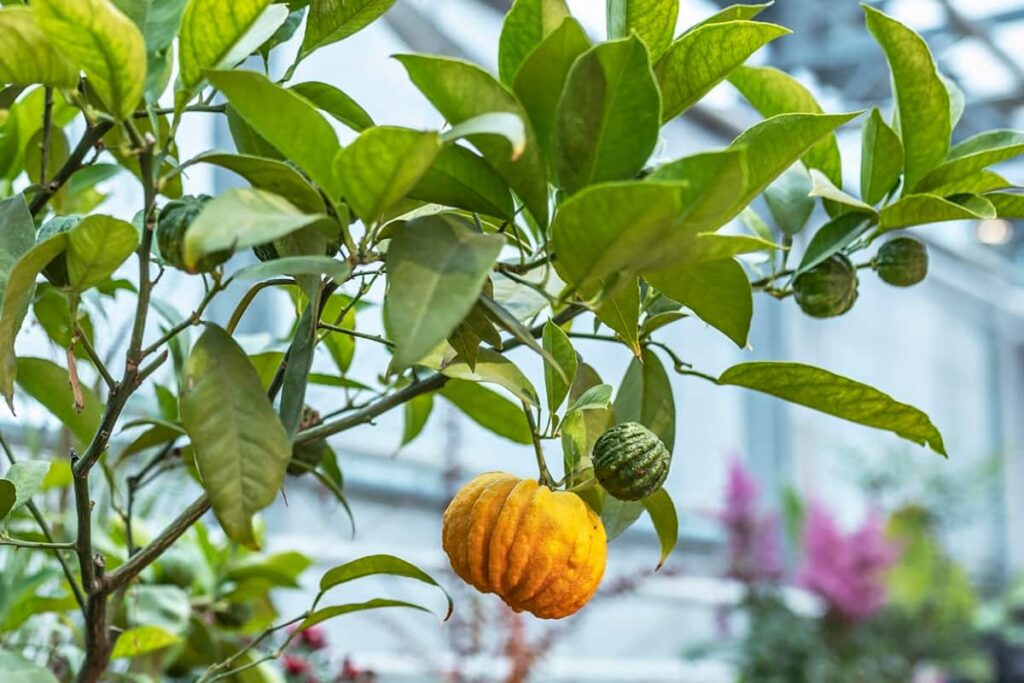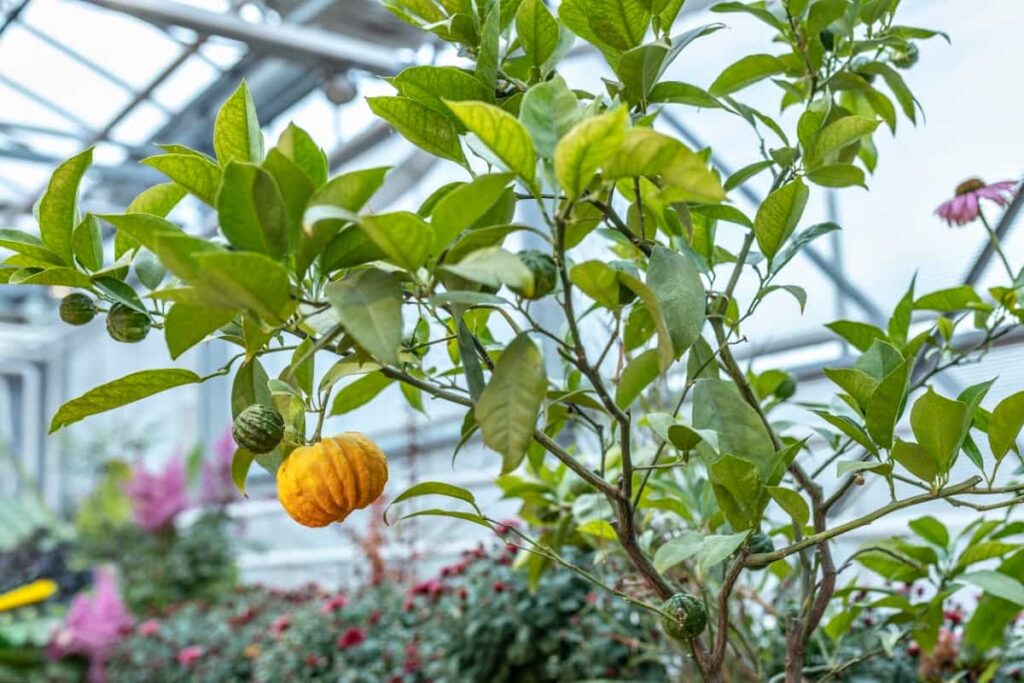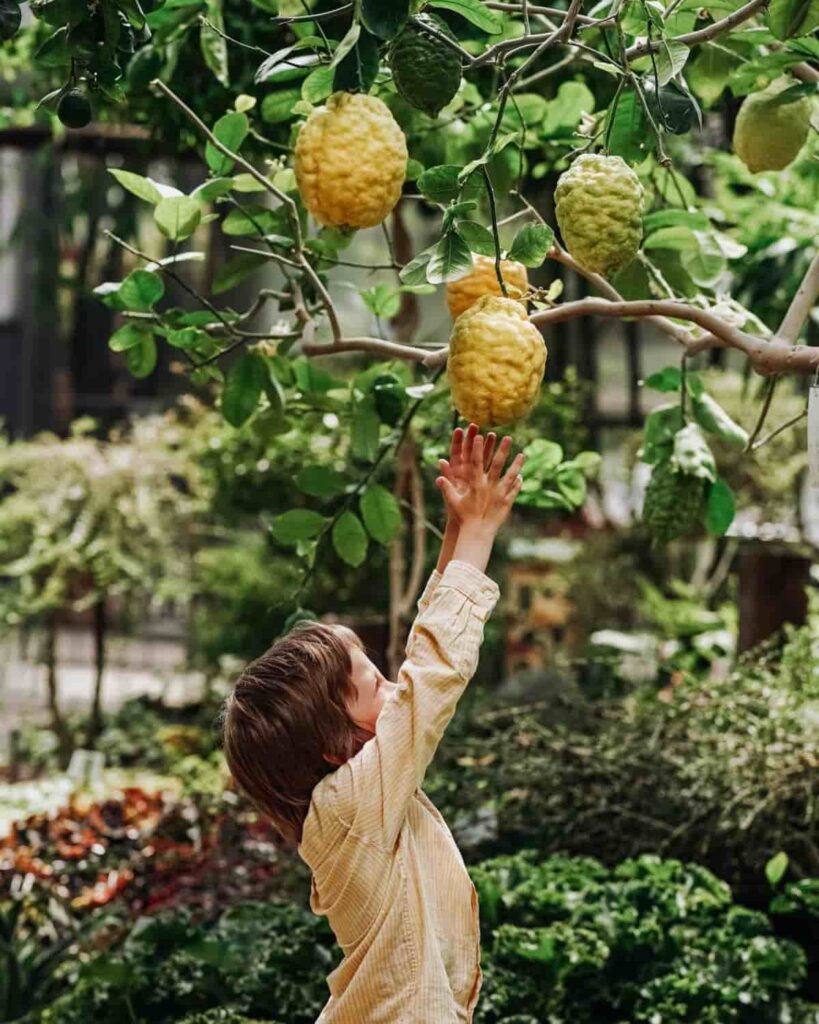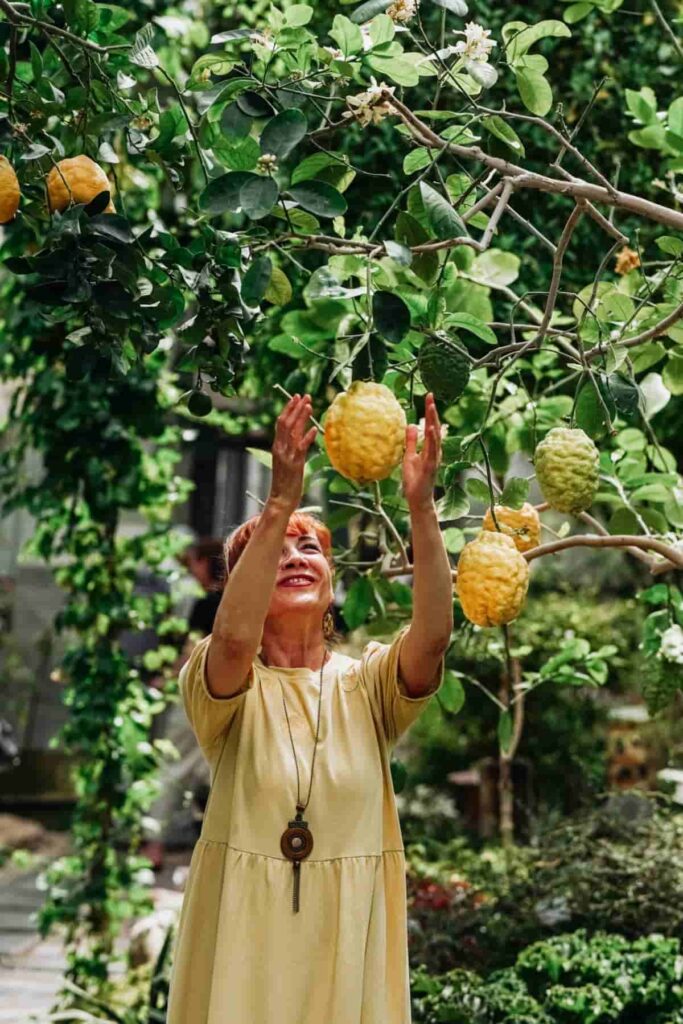Citron (Citrus medica) is a small evergreen tree or shrub in the Rutaceae family, cultivated in Mediterranean countries and the West Indies. Citron, also called Tipolo or Moli-apatupatu in Samoa and kou-yuan in China. The Citron plant is characterized by its slow growth, making it an interesting addition to any garden or orchard.

Guide to Growing Citron
Citron Tree Facts
| Item | Value-Information |
| Scientific name | Citrus medica |
| Origin | South-East Asia |
| Family | Rutaceae |
| Propagation | By seeds, cuttings, and air layering |
| Varieties | Buddha’s Hand, Etrog, Fingered Citron, and Diamante Citron |
| Appearance | Large, fragrant fruit with a thick, bumpy peel, bushy appearance, with thorny branches. |
| Texture | A rich pineapple yellow |
| Growing Zones | 9-10 |
| Taste | Very sour |
| Seasonality | Bears fruit at all seasons of the year |
| Culinary Uses | Used to make jam in pickles and preserves |
| Storage | Keep up to a week when stored at room temperature, also in the refrigerator. |
| Tree size | 8 to 15 ft |
| Soil pH level | 6.0-7.0 |
| Where to Buy | Local plant nurseries, online or any garden centers |
Choosing the Right Variety
When it comes to growing Citron, there are several varieties to choose from. Each Citron variety has its unique characteristics and flavors, allowing you to experiment and find the one that suits your taste buds best. The best Citron varieties are Buddha’s Hand, Etrog, Fingered Citron, Diamante Citron, and Corsican Citron.
Planting Your Tangelo Tree
Timing: When it comes to planting your Citron tree, choosing the right time is important. It is best to plant in early spring or fall when temperature levels are mild and there is less stress on the young plant. This allows the roots to establish themselves before facing extreme weather conditions.
Location: This unique and versatile fruit thrives in warm climates, making it ideal for Mediterranean regions and tropical areas. When selecting a location for your Citron tree, look for an area that receives at least six hours of direct sunlight each day.
Soil: Citron trees thrive in well-draining soil that is rich in organic matter. Sandy loam soils are ideal for Citron cultivation, as they offer good drainage while retaining enough moisture for plant uptake. Maintaining proper pH levels is also important for healthy Citron growth. Aim for an acidic to neutral pH range between 6.0 and 7.0.
Methods of Propagation
One common propagation method of Citron is through seeds. To begin, soak the seeds in water overnight to help soften their outer coating. Then, plant seeds in a well-draining potting mix about half an inch deep. Place the pot in a warm place with plenty of sunlight. Another way to propagate Citron is through air layering. This technique involves making a small incision on a mature branch and wrapping it with moss or damp sphagnum moss. Secure it tightly and keep it moist until roots start to develop.
Once roots have formed, cut the branch below the newly formed root system and transplant it into its container. For those looking for quicker results, taking cuttings from an existing healthy citrus tree is another viable option. Select a young stem that has at least three nodes present and remove any leaves from the lower part of the cutting before planting it in a well-draining rooting medium.
Watering and Mulching
With proper watering, the plant receives adequate moisture without being overwatered, while mulching helps to conserve soil moisture and suppress weed growth. When it comes to watering your Citron tree, it’s important to strike a balance. The best approach is to water deeply, allowing the soil to dry out between waterings. Mulching is another crucial practice for maintaining healthy Citron trees. Mulch also acts as a weed barrier, minimizing competition for nutrients and moisture.
In case you missed it: Insect Pest Management in Citrus: Biological, Chemical, and IPM Control Strategies

Fertilizing
Fertilizing is a crucial step in growing Citron trees. It provides essential nutrients that the tree needs to thrive and produce healthy, abundant fruit. Choose a balanced fertilizer specifically designed for citrus trees. Look for one with equal amounts of nitrogen, phosphorus, and potassium (NPK). When applying the fertilizer, spread it evenly around the tree base, avoiding direct contact with the trunk. It’s important to fertilize regularly throughout the growing season, typically starting in early spring and continuing until late summer.
Pruning and Training
When it comes to pruning, start by removing any dead or diseased branches. This will improve the overall tree appearance and also prevent potential diseases from spreading. It’s important to prune carefully, making clean cuts just above a bud or lateral branch.
Training your Citron tree involves shaping its growth in a specific way. This can be done by selectively pruning certain branches to encourage upward growth or create an open-center structure. The goal is to achieve a well-balanced canopy that allows sunlight and air circulation throughout the entire tree.
Pest and Disease Management
By following the right strategies, you can protect your plant from potential damage and ensure its healthy growth. One common pest that affects Citron trees is aphids. These insects feed on the sap of the leaves, causing them to turn yellow. To control aphids, you can use natural remedies like neem oil or insecticidal soap. Another pest to watch out for is citrus leaf miner.
To prevent leaf miner infestations in Citron, it’s important to keep your trees well-maintained by pruning off affected branches and using sticky traps to catch adult moths. Citrus greening disease, also called huanglongbing (HLB), poses a significant threat to Citron trees. To effectively control pests and diseases in your Citron tree, it’s essential to practice good cultural practices such as proper watering techniques, adequate spacing between plants for better air circulation, and regular fertilization with balanced nutrients suitable for citrus trees.
When and How to Harvest
Citron trees typically produce fruit within 3-4 years after planting, so patience is key. The best time to harvest Citron is when the fruit turns a vibrant yellow color. To harvest your Citron, gently twist the fruit from the stem or use sharp pruning shears to cut it off. Be careful not to damage the tree or any surrounding branches while doing so.
Winter Care
As the temperatures drop and the days become shorter, it is essential to provide proper care for your Citron tree during winter. Firstly, protect your Citron tree from frost. Cover it with a frost cloth on nights when temperature levels are expected to dip below freezing. This will help insulate the tree and prevent damage to its delicate leaves and branches.
Another important aspect of winter care is watering. Water deeply once every two weeks or so, depending on rainfall levels in your area. Mulching around the tree base can also provide added insulation and moisture retention. Pruning should be done sparingly during winter months, focusing primarily on removing dead or damaged branches. Avoid major pruning until spring, when new growth begins.
Growing in Citron Containers
When choosing a container, opt for one that is large enough to accommodate the root system of your Citron tree. A pot or container with a diameter of at least 18 inches is recommended. Select a potting mix specifically formulated for citrus trees. Place your container in a location that receives six hours of direct sunlight each day.
In case you missed it: Citrus Farming in Malaysia: Cultivation Practices, Production Cost, and Profit

Water your potted Citron regularly, keeping the soil evenly moist but not soggy. Avoid overwatering the Citron plant, as it can cause root rot and other issues. Fertilize your Citron tree every four weeks during spring and summer using a balanced citrus fertilizer according to package instructions. This will help promote healthy tree growth and fruit production.
Common Challenges
The main challenge for growing Citron is finding the right balance of water for your Citron tree. Overwatering the Citron plant can lead to fungal diseases, while underwatering can cause stress and hinder growth. It’s important to adjust the moisture levels in the soil and adjust your watering accordingly.
Citron trees also require proper pruning and training to promote healthy growth. Furthermore, weather conditions can pose a challenge for growing Citron successfully. Extreme heat or cold temperatures can stress the plant or even damage it permanently. Protecting your tree during harsh weather events is crucial for its survival.
Yield
Yield is an important factor for growing Citron. It refers to the quantity of fruit that your tree produces. The yield of a Citron tree can change based on several factors, such as the variety, growing conditions, and care provided. On average, a mature Citron tree yield can produce anywhere from 50 to 100 fruits per year.
In case you missed it: 15 Best Fertilizers for Citrus Tree: Homemade, Organic, Liquid, NPK, Schedule, and Prices

Conclusion
Citron is a slow-growing shrub that reaches a height of about 8 to 15 ft. The beauty of growing Citron lies in its ability to enhance both your garden aesthetics and your overall well-being. This ancient fruit has been cultivated for centuries and holds great significance in various cultures around the world.
- Aquaponic Farming at Home: A Step-By-Step Guide
- Profitable Village Farming Business Ideas in 2024
- High-Yield Aquaculture: Fast-Growing Fish for Farming
- Effective Fish Pond Construction Techniques for Beginners
- Irrigation and Water Management in Pineapple Farming
- Blossom to Harvest: Mastering Flowering and Pollination in Papaya Farming
- Pig Fattening Essentials: From Selection to Sale for Beginners
- Raising Wagyu Cattle: A Complete Guide for Premium Beef Production
- Soil Types and Their Water Holding Capacity
